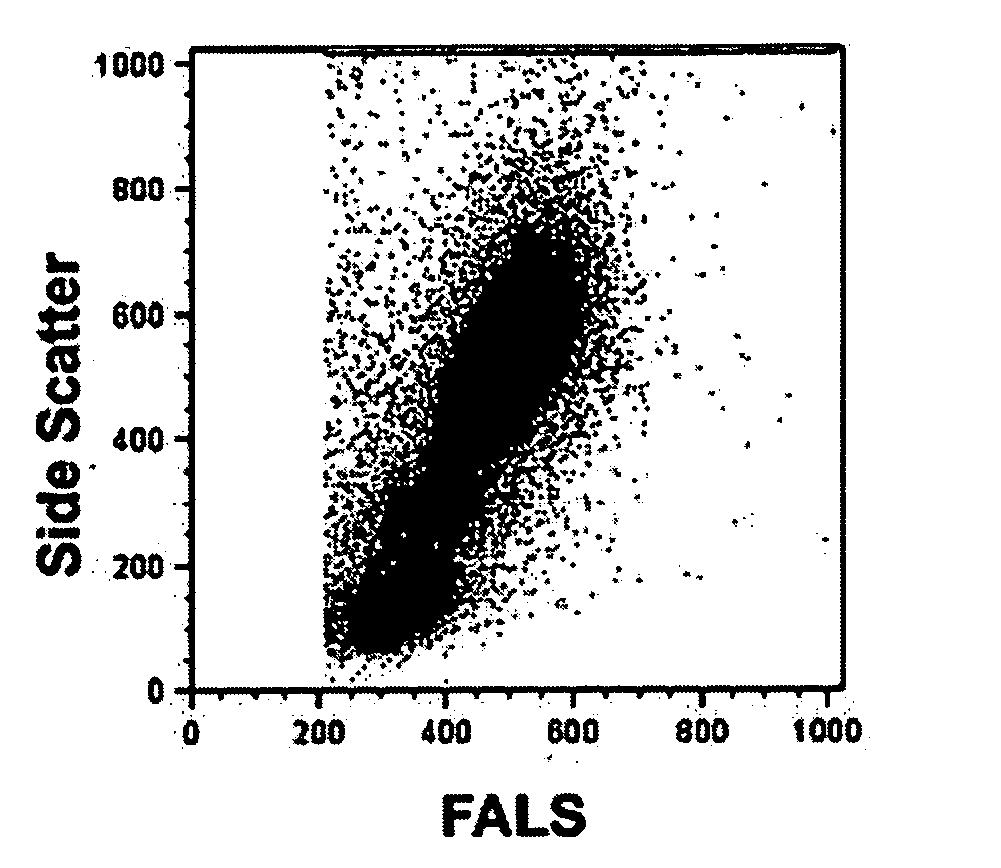Whole blood preparation for cytometric analysis of cell signaling pathways
a cytometric analysis and whole blood technology, applied in the field of sample preparation for cytometry, can solve the problems of inability to address methodologies, undetectable significant information on immune cell population variations that exist in both defined cellular populations and across different cell subtypes, and inability to provide information about the functional responses of those cells to stimuli immediately reflective of intracellular events
- Summary
- Abstract
- Description
- Claims
- Application Information
AI Technical Summary
Benefits of technology
Problems solved by technology
Method used
Image
Examples
example i
Red Blood Cell Lysis, Fixation and Permeabilization of Whole Blood Samples
[0061] This example describes and compares preparation of whole blood samples by hypotonic lysis followed by fixation and detergent lysis subsequent to fixation.
[0062] Briefly, Phorbol myristate acetate (PMA, Sigma Chemical Corp., St. Louis, Mo.) was prepared as a 40 M working solution in 100% anhydrous ethanol and used in whole blood at a final concentration of 400 nM. Triton X-100 and other detergents used in the examples were purchased as the Surfact-Pak™ Detergent Sampler kit from Pierce Biotechnology (Rockford, Ill.). The Sampler kit contains seven different non-ionic detergents (Tween-20, Tween-80, Triton X-100, Triton X-114, Nonidet P-40, Brij-35 and Brij-58, all supplied as 10% solutions in water), and three powders (nonionic Octyl-B-Glucoside, and Octyl-B-Thioglucopyaranoside, and zwitterionic CHAPS). Powdered detergents were dissolved in PBS (Ca++ and Mg++ free) to make 10% solutions. All detergent...
example ii
Impact of Fixation Agent and Detergent Concentrations on White Blood Cell Light Scatter
[0081] This example demonstrates the impact of concentration and incubation times for both fixative agent and detergent on the resolution and recovery of white blood cells.
[0082] Based on previous studies that suggested that higher concentrations of cross linking fixative helps retain light scatter profiles and resolution of white blood cell populations, the impact of different fixative concentrations was investigated. Whole blood samples were fixed at room temperature or at 37 deg. C. for 10 minutes in increasing concentrations of formaldehyde (from 1% to 10% final concentration), then immediately incubated with 1 ml 0. 1% TX-100 (at room temperature). As shown in FIG. 6, increasing formaldehyde concentration from 2% to 4% (for room temperature incubation) significantly improved the resolution of white blood cell populations (left panels). Similarly, treatment of whole blood samples with formal...
example iii
Impact of Alcohol Unmasking Agent on P-ERK and Impact on CD3 Expression
[0087] This example demonstrates the impact of alcohol on lymphocyte recovery and unmasking of surface epitopes.
[0088] In order to “unmask” phospho-protein (and other) epitopes rendered unreactive following fixation with cross linking fixatives, a series of experiments was undertaken to evaluate the impact of alcohol treatment following detergent treatment. Following 30 minute exposure to detergent, fixed whole blood samples were washed with cold (4 deg C.) buffer (PBS w / o Ca++ or Mg++) and resuspended in a series of different concentrations of methanol or ethanol at 4 deg C. One aliquot of each sample was held overnight at 4 deg. C. to investigate the impact of storage in alcohol solutions. As before, samples were stained (following removal of alcohol by centrifugation and washing in PBS) with antibodies to CD3-PE (to evaluate T-lymphocyte recovery and staining) and phospho-ERK (to evaluate epitope unmasking)....
PUM
| Property | Measurement | Unit |
|---|---|---|
| temperature | aaaaa | aaaaa |
| time period | aaaaa | aaaaa |
| time period | aaaaa | aaaaa |
Abstract
Description
Claims
Application Information
 Login to View More
Login to View More - R&D
- Intellectual Property
- Life Sciences
- Materials
- Tech Scout
- Unparalleled Data Quality
- Higher Quality Content
- 60% Fewer Hallucinations
Browse by: Latest US Patents, China's latest patents, Technical Efficacy Thesaurus, Application Domain, Technology Topic, Popular Technical Reports.
© 2025 PatSnap. All rights reserved.Legal|Privacy policy|Modern Slavery Act Transparency Statement|Sitemap|About US| Contact US: help@patsnap.com



